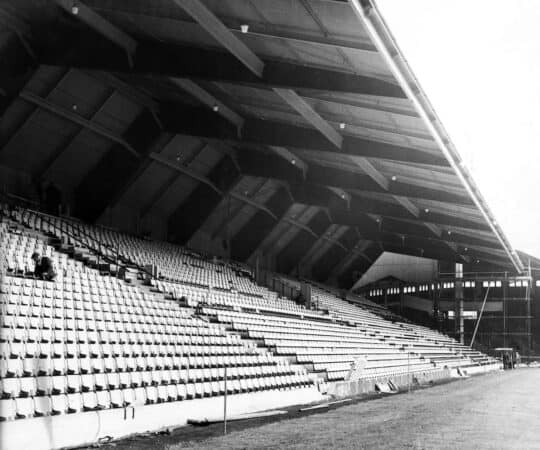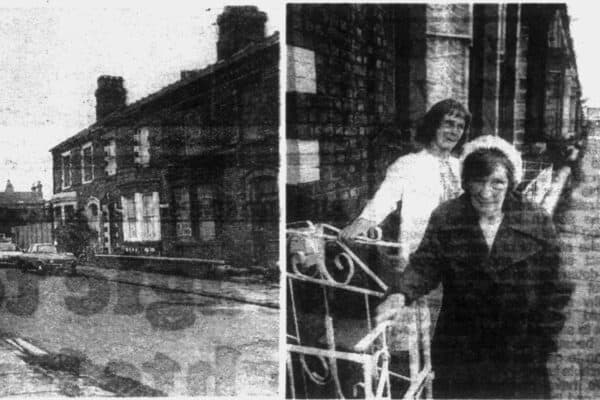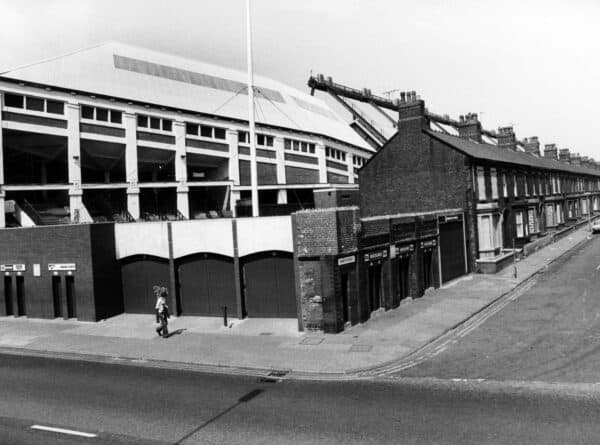Liverpool FC may be a global institution, but the defiance of two women alone delayed Anfield’s development for 12 years.
The story of 26 Kemlyn Road is a peculiar one.
No longer standing, the house that stood at this address became something of a landmark in the 1980s as the last remaining building on its street.
You see, since the 1970s, Liverpool had been planning to develop the Kemlyn Road side of Anfield, now known as the Sir Kenny Dalglish Stand, and had been gradually buying up the houses on the road behind the stand.

The club wanted to redevelop the Kemlyn Road stand in order to modernise the ground, introducing executive boxes, more seats and adding an extra tier.
However, their plans were thwarted for more than 10 years by sisters Norah and Joan Mason, who had lived at No. 26 for 39 years when the club submitted their initial planning application in 1980.
Initially five families had rejected the club’s proposals, but by 1984, Liverpool had bought every house except theirs on Kemlyn Road and knocked the properties down, leaving the sisters living in the sole remaining occupancy behind the stadium.
They refused to move despite the proposal of 15 alternative homes in close proximity – one even being offered for just five pence per month for the rest of their lives, according to a Liverpool Daily Post report from the time.
The situation became a running saga that prevented the club’s development of Anfield throughout the 1980s. With Liverpool unable to extend the stand, the road became wasteland and turned into a car park.


Image: Liverpool Daily Post
Amid criticism from the community and local councillors about rubbish build-up and the general state of the road, Liverpool chief executive Peter Robinson responded aggressively: “Councillors should look at the state of their city centre before making remarks about the car park.
“I have just walked foreign visitors round the city and they cannot believe the amount of rubbish.”
Seven years passed with the sisters acting as the sole occupants of Kemlyn Road, but Lord Justice Taylor’s report after the 1989 Hillsborough disaster, recommending that top-flight stadiums should become all-seater, accelerated the club’s need to reach an agreement.
Eventually, in 1990, the parties reached an out-of-court settlement that led Norah and Joan to leave, subsequently using their compensation to buy a new house in Southport.


Counsel for Liverpool David Geey said in 1990: “The sisters, Norah and Muriel (Joan) Mason, have been concerned throughout only to remain in the house which has been their home for 50 years, and no money can compensate them for the loss of this.”
Though the sisters’ defiance frustrated many, Judge Dennis Clark of Liverpool County Court added that Liverpool FC had “exercised a great deal of patience, understanding and sensitivity” and had “behaved honourably.”
With the house now able to be knocked down, Liverpool got to work on the redevelopment of the Kemlyn Road stand.
It was officially opened in 1992 by UEFA president Lennart Johannson and renamed as the Centenary Stand to celebrate 100 years since the club’s inception.
The stand could now hold 11,000 people and has remained in a similar state since the early 1990s.
The Kop, Main Stand and Anfield Road End have all since been redeveloped, but it is unlikely we will see any further expansion to the Sir Kenny Dalglish Stand for several reasons, including the demolition of Skerries Road that would be required.
Source link

















Add Comment